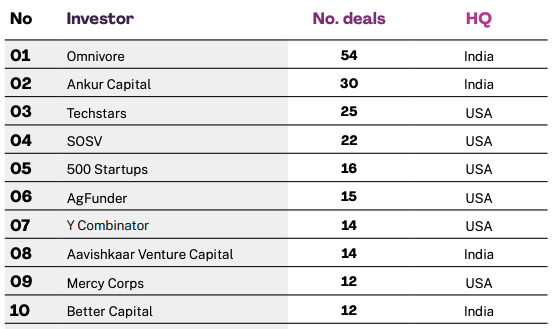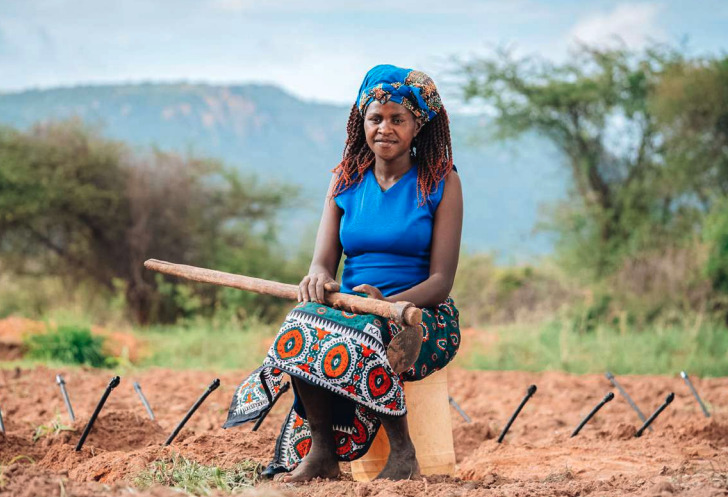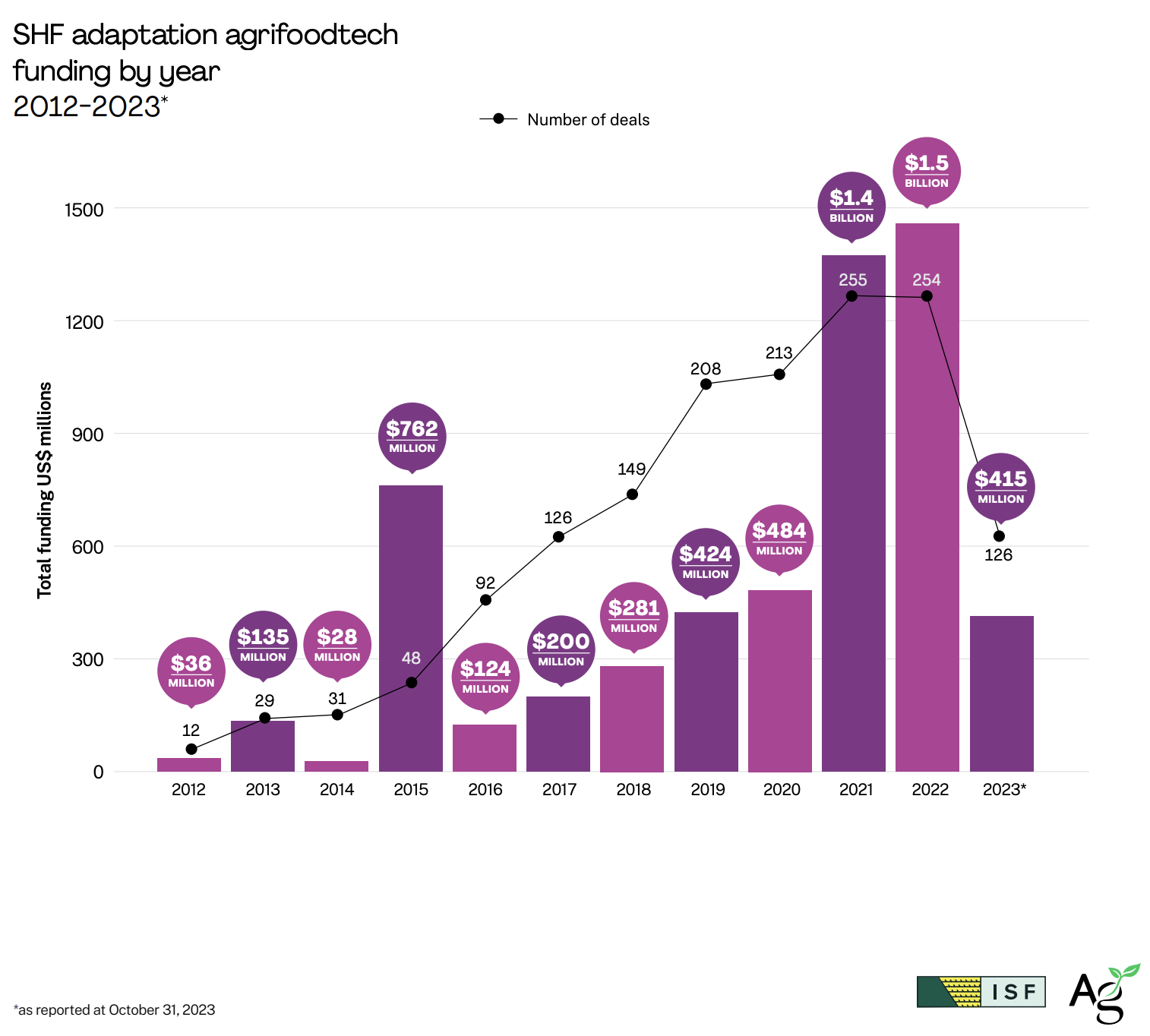Data Snapshot is a regular AgFunderNews feature analyzing agrifoodtech market investment data provided by our parent company, AgFunder.
Click here for more research from AgFunder and sign up to our newsletters to receive alerts about new research.
Climate adaptation is underfunded globally but especially so in emerging markets.
Developing countries alone need some $212 billion per year by 2030 to adapt to increasingly inhospitable growing conditions in agriculture, according to a recent report from AgFunder and ISF Advisors.
But it can be a challenging space to invest in, say investors.
“The adaptation project pipeline is lacking, with hazy financial incentives compared to clear revenue models like renewable energy,” Omnivore managing partner Mark Kahn tells AgFunderNews. “Overcoming this imbalance necessitates developing a robust adaptation portfolio, quantifying benefits, and making a strong case for financing resilience measures – critical to reinforcing our food systems against mounting climate threats.”
Omnivore is an Indian agrifoodtech venture capital firm that the report identified as the most active investor in climate adaptation technologies for smallholder farmers. The report focused on tools and services for the world’s smallholder farmers (SHFs) who contribute to one-third of the world’s food supply.
According to the report, climate adaptation agrifoodtech tools and services targeting SHFs have raised $5.7 billion since 2012 from tech investors, predominately venture capital, private equity and impact funds but also including corporate and bank capital. The funding totals and the number of deals steadily increased over that period, except in 2023 when the entire VC market, including agrifoodtech, entered a downturn.
Climate adaptation takes a backseat to mitigation tools and services that account for 90% of climate financing, according to the Climate Policy Initiative. (See below for the distinction.)
The report defines mitigation as “the measurable reduction of greenhouse gas emissions.” In agrifood, mitigation relates to things like corporate “net zero” commitments and discussions around “decarbonizing” supply chains.
Adaptation, on the other hand, doesn’t have a set definition — one of the reasons it’s a more challenging area to invest in. The report defines it as “measures taken to minimize the adverse impacts of actual or expected future climate change or to exploit beneficial opportunities.”
At the same time, the analysis notes that there “is no one-size-fits-all definition of adaptation.”
“Mitigation projects offer more quantifiable, short-term returns, aligning with tech investors’ bias towards tangible innovations over long-term adaptation efforts,” says Kahn.
Who is investing in climate adaptation tech for smallholder farmers?

Despite the downturn and the challenges around investing in adaptation, there are several who see the opportunity.
“There are promising opportunities for investing in climate adaptation tech, especially as the need for climate resilience grows,” notes Michael Dean, founding partner of AgFunder, another leading investor in adaptation technologies identified in the report. [Disclosure: AgFunder is AFN’s parent company]
“The immediate challenge is funding and the lack of financial infrastructure to ensure stability and to allow the emergence of a vibrant adaptation startup ecosystem.”
While most of the top investors hail from the US, technologies founded out of India attracted the most investment. That’s likely because it’s by far the most developed agtech ecosystem in the emerging markets and international investors have more comfort investing there.
Indian companies like DeHaat, Ecozen and Cropin are developing agribusiness marketplaces, solar irrigation, and precision agriculture, respectively, to help farmers adapt to and be more resilient to climate change. [Disclosure: DeHaat is an AgFunder portfolio company.
Dean also names drought-resistant crops, precision agriculture, and smart irrigation systems, all of which “are crucial for building resilience against climate impacts, especially in emerging markets. Effective tech transfer will be crucial in the decades ahead.”
Echoing that, Kahn notes that, “fortifying smallholder livelihoods against escalating climate risks is crucial.” He says Omnivore is especially focused on “agri-fintech, agri-climate finance, agrifood life sciences, and deeptech startups innovating for efficient smallholder production and post-harvest operations.”
However, it’s not just financial investors placing bets in agrifood adaptation tech deals; some 47 corporations have made adaptation investments, predominantly from their venturing arms, contributing to $1.1 billion in funding – nearly 20% of the total $5.7 billion in adaptation agrifoodtech funding – across 85 deals.

MDI Ventures, the venturing arm of Indonesia’s telecommunications giant Telekom, has been the most active corporate venture investor to date, making nine investments, followed by Telefonica’s Wayra, Indonesia’s Bank Rakyat Indonesia, Malaysian multinational Genting and Norwegian chemicals giant Yara.
Yet, venture capital is just one financing tool in the toolbox for SHF adaptation, as is technology just one type of solution, details the report. There are varied adaptation initiatives at play, many of which are low to no-tech and the capital sources backing them vary widely — from commercial banks and non-banking financial institutions to microfinance providers and private investors.
The infographic from the report below highlights the various investor groups backing smallholder adaptation in varying capacities with a few select examples.
Climate adaptation investor landscape:
By volume of capital deployed, venture capital and other tech investment is a much smaller channel compared to capital providers like local and international banks (see below graphic for an estimated comparison). Yet it is an essential source of capital for the creation of technologies that will surely be needed to help SHFs adapt to climate change and keep up with the rest of the world where tech advancements are accelerating rapidly. Furthermore, it often acts as a precursor to other forms of financing and therefore a proxy for future trends, argue the report’s authors

according to ISF Agri-SME report and AgFunder analysis
Are you investing in climate adaptation? We’d love to hear from you! Email [email protected]






